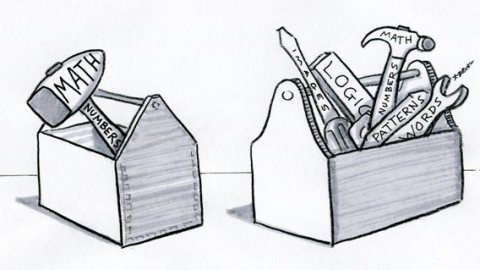The Poetics of Data: Science Depends on Precise Metaphors

Science and poetry both depend on metaphor. Science typically uses at least two. The first is usually Pythagoras’s astonishingly fruitful, but also limiting, “all things are numbers.” The second shapes what “the data” means. Good data needs good metaphors.
Nate Silver says journalists who aren’t “quantitatively inclined, rigorous and empirical,” lack discipline and risk creating “a lot of bullshit.” Responses range from Leon Wieseltier calling him a “data mullah,” to Noah Smith complaining he’s “barely data-driven.” The critics haven’t noted another problem: in describing his “data journalism” mission, Silver uses a chart where the “x-axis runs from ‘quantitative’ to ‘qualitative’.” But that misrepresents the relationship, quantities aren’t useful without good prior qualitative distinctions. The numbers need labels and the ideas they bring. Silver has worked mainly in sports and election results, where the numbers have clear meaning built in. Other fields, like economics, aren’t so lucky.
E. O. Wilson advises scientists to “think like poets and work like accountants.” The number crunching builds on the poet’s skill of making good metaphors (poetry comes from the Greek for “to make or compose“). Metaphors are the muscles that animate the conceptual skeletons we use. Even if as Galileo puts it “The Book of Nature is written in the language of mathematics,” other metaphors are needed.
Deirdre McCloskey calls Gary Becker “an economic poet” because she likes his metaphors: “the family as a little firm,” “children as durable goods.” (I’ve complained about Becker comparing heroin to bowling.) Metaphor making is part of the genius of science. Darwin said natural selection crystallized for him by analogy with Malthus’s essay on population limits, and Joule’s energy conservation arose by analogy with balancing account-books. For examples of badly used metaphors see: Shakespeare’s invisible hand in economics.
Gross domestic product, says Diane Coyle is our tarnished “principal measure of progress.” It doesn’t distinguish “bads” (like wasteful healthcare spending) from genuine goods, and omits everything that has no market value. Yet many obsess about GDP growth. But couldn’t GDP reductions, if achieved by eliminating “bads,” be progress?
Silver worries about “priors” (biases) but doesn’t distinguish input-priors from method-priors from goal-priors. His doctrine of “data journalism” is both an input-prior and a method-prior. (He’s a method-hedgehog in foxes’ clothing.) It discounts whatever isn’t in the numbers and is prone to qualitative weaknesses in their underlying ideas, like the assumption that all economic activity is good. Much data now comes with hidden priors (e.g. from think tanks confessedly pre-committed to particular goals.)
The cult of calculation and data is seductive. And I’m no quantiphobe. But numbers and mathematics have no monopoly on precision or truth. Words, logic, images, and patterns can be exact and can describe more than numbers can. Fit the tool to the task, and the metaphor to the situation. Good quantitative reasoning needs good qualitative priors.
Illustration by Julia Suits, The New Yorker Cartoonist & author of The Extraordinary Catalog of Peculiar Inventions.
Correction: An earlier version of this post used the sentence “Nate Silver said journalism that isn’t quantitative is “bullshit” That has been changed to “Nate Silver says journalists who aren’t “quantitatively inclined, rigorous and empirical,” lack discipline and risk creating “a lot of bullshit.” Thanks to Adam Gurri @adamgurri for pointing out the inaccuracy (and for the introduction to McCloskey’s work on the Rhetoric of Economics, and Bourgeois Virtue Ethics).





